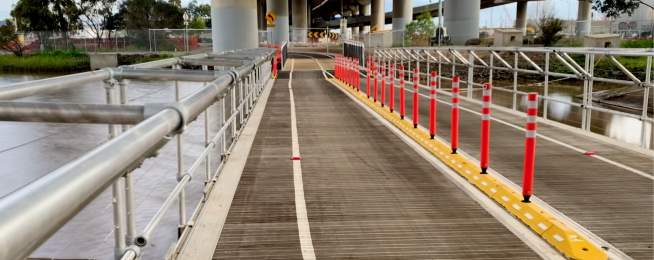Riders will be relieved that there is no longer a risk of hitting the deck on the pontoon bridges over the Moonee Ponds Creek in West Melbourne because of the sometimes slippery rubber connector.
A flexible strip of bollards now forms a median across the bridge, ensuring that it is physically impossible for a bike tyre to come into contact with the join along the centre.
This should ensure that the fine, upright citizens of Melbourne out for their allowed hour of exercise along the Capital City Trail remain upright.
Previously several riders have taken a spill in wet conditions when attempting to cross the centre line into the oncoming lane.
They report that their wheels have slipped on the rubber strip that runs down the centre line of the pontoons.
The bridges actually comprise two floating pontoon structures that are joined by the rubber strip that enables them to float independently.
Of the two pontoons, the one upstream of Dynon Road appeared more problematic, possible because the freeway structure immediately overhead would drip moisture onto the pontoon below for an extended period after rainfall.
Bicycle Network has worked with the West Gate Tunnel Project and contractors to assess the problem and devise a solution.
The flexible bollards neatly cover the centre join, but still enable the pontoon structure to flex as designed to account for rising tides and variations in the flow of the Creek.
Riders should understand that this change does mean that crossing the centre-line to overtake is no longer possible, so care needs to be taken when other trail users are on the bridge.
Bicycle Network thanks the riders who provided feedback about the bridges and the problems.
Just between the two pontoon crossings the project has in stalled traffic lights to ensure riders get across Dynon Road safely.
However there have been corroborated reports of drivers on occasion failing to stop, or stopping over or beyond the stop line, creating a risk of collision with riders with the green.
This could be because some drivers are used to there being no signals at this point previously, and, not paying proper attention, failed to the red that is there now.
Whatever, riders should be alert to this problem. The crossing will be in place for the next year, plenty of time for drivers to adjust.
Become our friend
Find out more about Bicycle Network and support us in making it easier for people to ride bikes.


